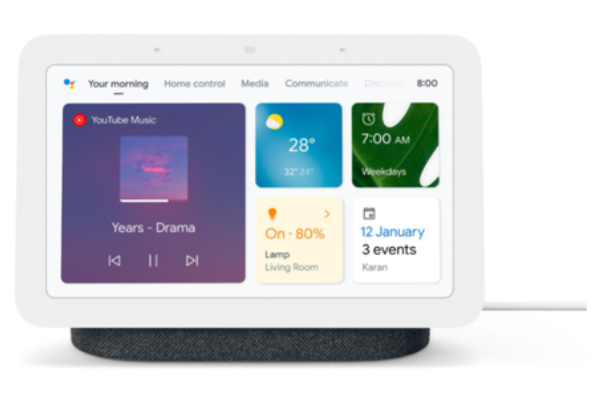Google Releases New Nest Hub in India Without Sleep Sense Feature
 Google has launched the new generation of Nest Hub smart displays in India almost a year after their debut in the U.S. However, Indian regulations prevent the company from offering the new radar-based Soli Sleep Sensing feature, the highlight of the new smart display.
Google has launched the new generation of Nest Hub smart displays in India almost a year after their debut in the U.S. However, Indian regulations prevent the company from offering the new radar-based Soli Sleep Sensing feature, the highlight of the new smart display.
No Sleep Sense
The seven-inch display in front of the fabric-covered speaker looks essentially the same as its predecessor. The improvements are primarily under the hood, but the Indian version of the new Nest Hub diverges sharply from its American counterpart in lacking the Soli Sleep Sensing feature. This opt-in tool uses tracks the nearest person’s sleep patterns. Radar measures their movement and breathing, and the AI analyzes that data in combination with changes in light, temperature, and sound throughout the night. The Nest Hub charts sleeping patterns and shares them on the wellness section of the smart display, along with advice on improving sleeping habits. Sleep Sensing will be free to start, but Google plans to connect it to a paid service eventually. The company claims 20% of Nest Hubs are placed next to people’s beds, making the feature worth developing.
Though all of the data is kept on the device, and the user can delete it at any time, Soli is not approved for use by the Indian government currently, so Google disabled it for that market. And while the feature is not mentioned by name in the announcement, the company hints obliquely at it by talking a lot about how important privacy is in designing the device.
“As we design our products, we focus on three important principles: keeping your information safe, treating it responsibly, and putting the user in control,” Google devices business manager Saurabh Arya explained in a blog post. “The new Nest Hub is designed from the ground up with privacy in mind, with controls for how your data is treated, and like the original Nest Hub it does not include a camera, so you can feel comfortable putting it in any room in your home.”
Indian Nest
The Nest Hub price of 8,000 rupees at retailers like Walmart subsidiary Flipkart is about the same as the $100 cost in the U.S. price tag in the United States. India is also missing the new Mist color option, leaving just Chalk and Charcoal choices like the previous version. Otherwise, the upgrades are identical, including the sound technology used in the Nest Audio smart speaker, which Google claims boosts bass sound by 50%, as well as a chip that keeps some of Google Assistant’s processing on the device to make it work faster.
Despite no sleep tracking, Google’s efforts to enhance its place in smart homes in India tie neatly into its expanding line of voice services. Google added Hinglish commands to the Google Pay app, which already handles a growing number of interpersonal and commercial monetary transactions. Now, that money can be moved by asking the app through the speech-to-text feature. Users simply have to say what bank and account number they want to send money to. Google Pay already understood Hindi and English, but adding the Hindi and English hybrid tongue Hinglish widens the audience significantly.
Google Assistant also recently started helping users set up COVID-19 vaccine appointments in India. The government’s COWIN service online has been difficult for many to use, so Google Assistant will help people complete all of the forms through voice in a pilot program. Google Assistant will fill out the forms and set the vaccination date in English or any of eight major Indian languages. While Google hopes to bring this kind of function to other countries, starting in India makes sense based on the country’s enthusiasm for voice assistants. Google reported that the number of Indians asking questions by voice is twice the average worldwide.
Follow @voicebotai Follow @erichschwartz
Google India Unveils Voice Banking and COVID-19 Vaccine Scheduling
Do Nothing Mode Gives Google Assistant a Sarcastic Wit to Promote Chocolate in India








